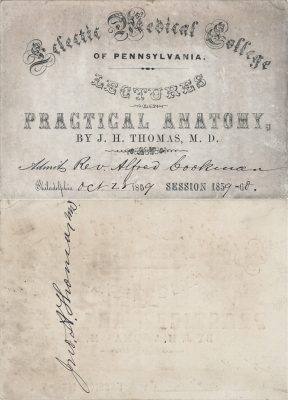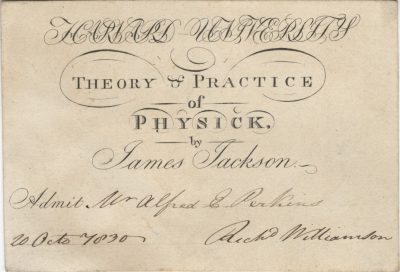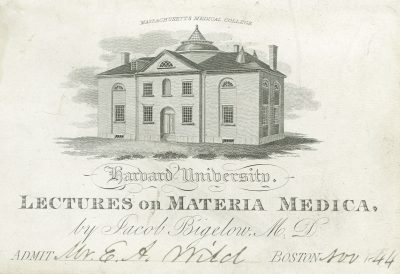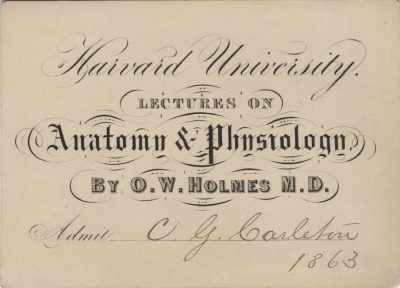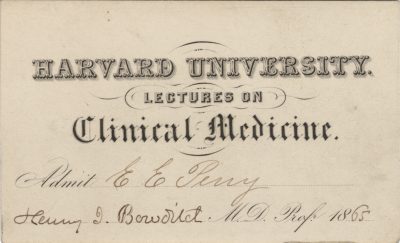17. Dalhousie College and University
| Dalhousie College and University 1902-03 Forrest, John (registrar) Johnson, Thomas R. Registration ticket |
|
| The Faculty of Medicine at Dalhousie College in Halifax, Nova Scotia, was founded in 1868 as Canada’s fifth medical school. As in the United States, physicians collected fees from the students. This Canadian medical school closed in 1873 and two years later an independent institution known as the Halifax Medical College (HMC) formed. By the mid-1880s HMC had a loose affiliation with Dalhousie University, which re-established a Faculty of Medicine in 1889. While HMC maintained control of teaching, the University oversaw examinations. After the Flexner Report identified “inadequate facilities for training,” the University reorganized and fully reincorporated the medical school in 1911.
Dalhousie University Archives and Special Collections – Digital Collections. History of Medicine at Dalhousie University. http://dal.ca.libguides.com/dalhousiehistory/historyofthefacultyofmedicine
|
|
18. Eclectic Medical College of Pennsylvania (discontinued)
| Eclectic Medical College of Pennsylvania (discontinued) 1859 Thomas, John H., MD Bookman (?), Rev. Alfred Anatomy |
|
|
The Eclectic Medical College of Pennsylvania was founded in 1851, six years after the nation’s first eclectic medical school opened in Cincinnati. This alternative medical school located in Philadelphia, a well-established hub of medical education. It began as a creditable institution, but in 1864 false claims earned the school the reputation as a diploma mill. An 1880 Puck cartoon satirized the school and “Professor Grind-Em-Out,” Dean James Buchanan, who was arrested for selling fake medical degrees. The school closed that year.
“The Impotence of Law.” The New York Times. June 14, 1880.
The Library Company of Philadelphia. Capitalism by Gaslight: The Shadow Economics of 19th-Century America. http://www.librarycompany.org/shadoweconomy/section7_5.htm |
|
19. Harvard University
| Harvard University 1830 Channing, Walter, MD Perkins, Alfred E. Midwifery and medical jurisprudence |
|
| Channing graduated from Penn (M1809), then continued to train in Boston under James Jackson, MD (22). Channing next studied in Edinburgh and London where he pursued his interest in midwifery. In 1815 Harvard appointed him the University’s first professor of obstetrics and medical jurisprudence, and he served as dean of the medical school from 1819 to 1847. Channing pioneered etherization in childbirth, his greatest accomplishment. After attending courses at Harvard, Perkins, like his midwifery professor, received his degree from Penn (M1833).
Kass, Amalie. “Walter Channing: Brief Life of a Nineteenth-century Obstetrician: 1786-1876.” Harvard Magazine. March-April 2004.
Kelly, Howard A. and Walter L. Burrage. American Medical Biographies. Baltimore: The Norman Remington Company, 1920. 205-06. |
|
20. Harvard University
| Harvard University 1830 Webster, John White, MD Perkins, Alfred E. Chemistry |
|
|
Webster, a graduate of Harvard University and Harvard Medical School, was a distinguished and socially prominent member of the Harvard faculty (1834 -1850). Though unsuccessful in private practice, he became a popular lecturer in chemistry and geology. His fine lifestyle, supported only by a modest income, led to severe financial problems. Webster fell deeply in debt to a number of friends and colleagues, including the physician, real estate developer and moneylender George Parkman, MD. On November 23, 1849, Parkman confronted Webster in his laboratory, demanding that he repay his debt, or be exposed and disgraced for financial recklessness. One week later a janitor discovered the remains of Parkman’s incinerated corpse. In one of the earliest American legal cases to rely on forensic pathology to identify a body, the Boston jury found Webster guilty of murder. Hoping to avoid execution by hanging, Webster confessed, but nonetheless met his fate on the gallows on August 30, 1850. (For Perkins, see 19.)
Stenographic Report: Trial of Professor John W. Webster for the murder of Dr. George Parkman in the Medical College. Boston: John A French, 1850. i-ii, 91.
Sullivan, Robert. The Disappearance of Dr. Parkman. Boston: Little, Brown and Co., 1971. 241. |
|
21. Harvard University
| Harvard University 1830 Warren, John Collins, MD Perkins, Alfred E. Anatomy and surgery |
|
| Warren, Harvard Medical School’s first dean, studied medicine with his father, John Warren, MD (Harvard Professor of Anatomy and Surgery), and pursued further training in surgery at several European hospitals. Upon returning to Boston in 1805 he taught private anatomy courses and a few years later joined the Harvard faculty. Although Harvard Medical School was founded in 1782, its administrative organization did not include a dean until Warren’s appointment in 1816. Warren and James Jackson, MD (22) helped establish the Massachusetts General Hospital, which opened in 1821 as the first teaching hospital for Harvard medical students. At this hospital in 1846 Warren and dentist William T.G. Morton, MD (Hon.) demonstrated one of the first uses of ether anesthesia for surgery. (For Perkins, see 19.)
Harrington, Thomas Francis, MD. The Harvard Medical School: A History, Narrative and Documentary, 1782-1905. Vol. 1. NY: Lewis Publishing Company, 1905. 366-370.
Harvard Medical School. “Past Deans of the Faculty of Medicine.” Massachusetts General Hospital. “History of Mass General.” http://www.massgeneral.org/museum/history |
|
22. Harvard University
| Harvard University 1830 Jackson, James, MD Perkins, Alfred E. Physick |
|
| Jackson (Harvard; M1809) became his alma mater’s first professor of clinical medicine in 1810. That same year he led early reforms of medical education at the Harvard Medical Institution when it moved from Cambridge to Boston and was renamed Harvard Medical School. His service at the Boston Dispensary and the Boston Almshouse created opportunities to offer Harvard medical students clinical instruction prior to the opening of Massachusetts General Hospital in 1821, an effort he spearheaded with John Collins Warren, MD (21). Jackson pioneered small pox vaccination in New England during a time of controversy about the practice. (For Perkins, see 19.)
Harrington, Thomas Francis, MD. The Harvard Medical School: A History, Narrative and Documentary, 1782-1905. Vol. 1. NY: Lewis Publishing Company, 1905. 370-75.
|
|
23. Harvard University
|
Harvard University 1844 Bigelow, Jacob, MD Wild, Edward Augustus Materia medica |
|
|
Bigelow received his bachelor’s degree from Harvard and attended medical lectures, but received his medical degree from the University of Pennsylvania (1810). He had a passion for botany and produced the illustrations for his Medical Botany. At Harvard he taught botany and materia medica, and received notoriety for his ideas about the self-limiting character of disease. Like Bigelow, Wild graduated from Harvard and attended medical lectures, but received his degree in Philadelphia (Jefferson; M1846). He practiced homeopathy until the Civil War when he opted for a battle command rather than the medical corps. After a series of lauded military feats, Wild lost an arm to injury and returned to Boston. An abolitionist, Brigadier General Wild raised black regiments including recruits for Robert Gould Shaw’s 54th Massachusetts Infantry. He also organized and commanded the all black 55th Massachusetts Infantry. “Wild’s African Brigade” carried out a meritorious and sometimes controversial campaign through the South.
Kelly, Howard A. and Walter L. Burrage. American Medical Biographies. Baltimore: The Norman Remington Company, 1920. 100-01.
Kingman, Bradford. Memoir of Gen. Edward Augustus Wild, H.U. 1844. Boston: 1895. Wikepedia. “Edward A. Wild.” http://en.wikipedia.org/wiki/Edward_A._Wild |
|
24. Harvard University
| Harvard University 1863 Holmes, Oliver Wendell, MD Carleton, C.G. Anatomy and physiology |
|
| Holmes, an 1829 graduate of Harvard College, studied in Paris and Edinburgh before returning to Harvard for his medical degree (M1836). This physician, poet, writer, and father of the famous jurist taught anatomy at Dartmouth, Berkshire Medical Institution and Tremont Street Medical School (extracurricular courses for Harvard medical students) before Harvard appointed him professor of anatomy and physiology, and dean (1847-1853). He held the anatomy and physiology post for 35 years. Holmes made his greatest contribution to medical science in identifying the transmission of puerperal fever from one woman to the next through the hands of physicians. His 1843 essay, which predated Semmelweiss’ research on the topic, met with controversy from his peers. During the 1871 reforms at Harvard Medical School, Holmes sided with the old guard who resisted giving up their autonomy and did not embrace the German-influenced movement toward laboratory science in medicine. Carleton received his Harvard medical degree in 1867.
Kelly, Howard A. and Walter L. Burrage. American Medical Biographies. Baltimore: The Norman Remington Company, 1920. 542-45.
Ludmerer, Kenneth M. Learning To Heal: The Development of American Medical Education. NY: Basic Books, Inc., 1985. 49. |
|
25. Harvard University
| Harvard University 1865 Bowditch, Henry Ingersoll, MD Perry, E.E. (Edward Everett) Clinical medicine |
|
| Bowditch, a pioneer in the specialty of diseases of the chest, graduated from Harvard College in 1828 and Harvard Medical School in 1832. He served as house officer at Massachusetts General Hospital under the tutelage of James Jackson, MD (22). Like others of his time, he pursued postgraduate study abroad in Paris, where he became proficient in examination of the chest by auscultation and percussion. Upon returning to Boston he wrote an instructional book on use of the stethoscope and introduced thoracentesis for the removal of pleuritic effusions with an instrument devised by Morrill Wyman, MD. Bowditch also became an ardent activist in the abolition movement. During the Civil War he visited battlefields in the South and successfully lobbied Congress to establish an ambulance system to aid suffering soldiers. In 1869 Bowditch chaired the Massachusetts State Board of Health, the nation’s first such organization. Bowditch’s student, Perry, received his Harvard medical degree in 1868.
Kelly, Howard A. and Walter L. Burrage. American Medical Biographies. Baltimore: The Norman Remington Company, 1920. 127-130.
|
|
26. Homeopathic Medical College of Pennsylvania (Hahnemann/Drexel University)
| Homeopathic Medical College of Pennsylvania (Hahnemann/Drexel University) 1849 Matthews, C. Bentley, MD Cushing, John Materia medica and therapeutics |
|
| Homeopathy grew from Samuel Hahnemann’s doctrine of similia similibus curantur – like cures like. If a substance produced symptoms similar to a disease, it should be used to treat that disease. In Philadelphia, a city of medical firsts, the nation’s first homeopathic medical school opened in 1848. Although the Homeopathic Medical College of Pennsylvania espoused a different philosophy of healing, its graduation requirements mirrored those of traditional medical schools. In 1867 a riff between two of the primary shareholders led to the formation of the Hahnemann Medical College of Philadelphia. The Homeopathic Medical College merged into Hahnemann in 1869. Cushing, who in 1853 opened an office in San Francisco, helped promulgate homeopathy’s presence on the West Coast. As of 1857 he was one of only five homoeopathic physicians in California. In 1873 he purchased property in Marin County where he built a sanatorium called Blithedale.
Bradford, Thomas Lindsley, MD. “Homœopathy in California.” In William Harvey, King MD, LL.D. History of Homœopathy and Its Institutions in America. http://www.homeoint.org/history/king/1-31.htm
“Homeopathic Medical College of Pennsylvania 1814-1869.” http://www.wholehealthnow.com/homeopathy_pro/homeopathic_medical_college.html Norwood, William Frederick. Medical Education in the United States before the Civil War. Phila: University of Pennsylvania Press, 1944. 416-17. Orbis Yale University Library Catalog. http://orbexpress.library.yale.edu/vwebv/holdingsInfo?bibId=10153638 |
|


